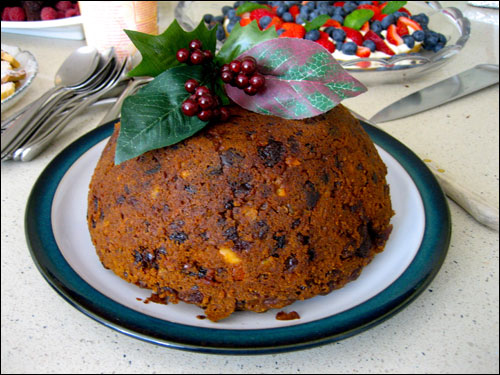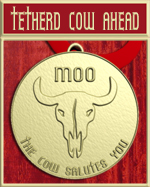Sun 27 Dec 2009
We Won’t Go Until We Get Some!
Posted by anaglyph under Australiana, Food & Drink
[9] Comments

An Australian friend of mine who now resides permanently in northern California was bemoaning to me yesterday that Americans don’t really seem to get the concept of the Christmas plum pudding. So for the education of my US readers, and for the nostalgia for my Australian readers, some reminiscences on the subject.
In my family’s celebrations, the plum pudding was an essential finale to the Christmas dinner. Let me set the scene for you so you can imagine the surreal experience of Christmas in Australia:
To begin with, you should understand that, because it is the middle of our summer, it is usually very hot here at Christmas (sometimes VERY hot; I remember one year at my parents’ place where the thermometer was creeping above 38ºC (100ºF) – and that wasn’t the one in the turkey). ((On that particular day, bushfires raged on three sides of us and the air was black with smoke and soot.)) But because of the English & European ancestry of most Australians, at Christmas we still surround ourselves with the icons of a Northern Hemisphere festival: decorated pine trees ((In our case the ubiquitous pinus radiata)), images of snow and snowmen, songs about chestnuts and open fires and big servings of totally inappropriate food, like roast turkey with potatoes and baked ham. Some years we attempt to escape from the shackles of a heritage that has well and truly outlived its welcome. This year it was our turn to host the Christmas lunch and we suggested that a barbecue & salads might be a nice idea but the looks of dismay and betrayal on the faces of relatives was so great that we caved in and did the turkey and potatoes. It’s mighty hard work flying in the face of tradition.
And I have to confess, even though I could forego most of the other stuff, I would really miss the plum pudding.
When I was a kid, the plum pudding was brought to the table aglow with blue brandy-fuelled flames. We were served generous slices smothered in custard and icecream. But the best part by far was that some fortunate person would get the ‘lucky’ sixpence or threepence hidden somewhere inside. Even though the the tradition of the plum pudding probably comes from the early nineteenth century, the notion of ‘lucky coins’ or ‘touch pieces’ probably reaches back as far as medieval times. In our case, the coin was always a pre-war minted sixpence, which was suitable to be cooked in a pudding owing to its high silver content (about 98%). After the war the coins were minted with about 50% copper, and could no longer be used. ((I remember that if we got the sixpence in the pudding, we had to ‘trade’ it with mum & dad, or our grandparents, ‘for luck’. Thinking back on it, the probability is that they kept a pre-war sixpence for the pudding, and traded it with a coin of recent minting that the lucky finder could go and spend))
When decimal currency was introduced in Australia in 1966, the copper content went to above 75% and so they were right out. ((Interesting tidbit from Wikipedi: “In May 2007, owing to the high market value of copper and nickel, the bullion value of the Australian 5c coin was about 6.5 cents, though there were no reported cases of hoarding or melting down of the coins despite the apparent 30% gross profit to be made from doing so.”)) Nevertheless, someone still always got a lucky coin – I later found out that it was slipped into the pudding just before serving, to avoid the probable copper contamination.
The plum pudding in the picture above was made by my mother-in-law and is truly excellent. Very fortunately for me, the rest of the family, completely stuffed from the turkey and roast potatoes, hardly ate any of it at Christmas dinner, so most of it is sitting in our fridge being whittled slowly away by moi.




Yeah, we threw off all them English traditions long ago.
Heck, some o us barely speak th language anymore.
Christmas pudding is all very well but I want some of those treats I can see in the background too
You don’t even want to know what they hide in the plum pudding in Russia.
[img]http://www.oldfishandlemonade.com/pix/seated30.jpg[/img]
Joey: I noticed
Nurse Myra: They were pretty good too, but there’s none of them left, alas.
Atlas: Well, if Yuliya had bothered to reply to my letters, maybe I’d have found out.
(And… N-O-O-O-O-O-O-O-O-O!
We have the dreaded fruit cake here in the US…
There’s no need to bring further attention to yourself, Malach.
It must be getting crowded on the moo-altar with all those bottles.
Malach: The only people who dread fruit cake are those with a screw loose.
Atlas: That’s unkind to fruit cakes.
Queen Willy: What bottles?